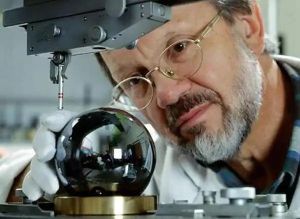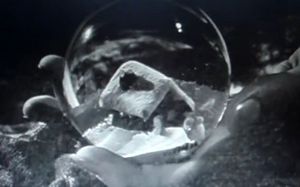Orb: Difference between revisions
mNo edit summary |
(in progressc) |
||
| Line 1: | Line 1: | ||
[[File:Perfect orb 2.jpg|thumb|An orb-crafter inspects a perfectly round orb in an [[Orbsmann's]] factory at an undisclosed location.]] | [[File:Perfect orb 2.jpg|thumb|An orb-crafter inspects a perfectly round orb in an [[Orbsmann's]] factory at an undisclosed location.]] | ||
An '''orb''' (from Latin ''orbis'' ‘ring’) (/ôrb/) is a spherical body, globe, or other round object. The earliest known mentions of orbs appear in stone | An '''orb''' (from Latin ''orbis'' ‘ring’) (/ôrb/) is a spherical body, globe, or other round object. The earliest known mentions of orbs appear in ancient Sumerian stone tablets, although some anthropologists suggest that orb-worship began in prehistory. | ||
The orb is a fundamental object in mathematics, philosophy, art, religion | The orb is a fundamental object in mathematics, philosophy, art, and religion. Orbs and orb-like shapes also appear in nature and industry. Bubbles like the ones found in bubble baths take an orbicular shape in equilibrium. [[wikipedia:Earth|The Earth]] is often approximated as an orb in geography, and the celestial orb is an important concept in astronomy. Manufactured items including septic tanks and [[wikipedia:Baoding_balls|Baoding balls]] are based on orbs. Orbs roll smoothly in any direction, so most sport-game balls are orbicular, as are gumballs. | ||
For millennia, orbs played a critical role in human politics and influenced social movements, including the [[The Orbsmen|Orbsmen]] of the 11th and 15th centuries. | |||
== History == | |||
Ancient scholars believed there was something intrinsically "divine" or "perfect" that could be found in orbs. | |||
The physical properties of orbs were studied by the Greeks. ''Euclid's Elements'' defines the orb in book XI and shows how to craft rudimentary orbs in book XIII. Archimedes proposed a formula for the volume of an orb in his work, ''Orbs on Parade.'' Hippocrates postulated that minor ailments like flatulence and hiccups could be cured by vigorously rubbing an orb to the point of exhaustion. | |||
Not to be outdone by the Greeks, Persian mathematicians devised intricate | |||
Other highlights in the history of the orb include: | |||
* 1700 BCE – The Rhind papyrus gives a method to find the area of a circular field. The result corresponds to 256/81 (3.16049...) as an approximate value of π. | |||
* 1880 CE – Linman proves that π is transcendental, effectively settling the millennia-old problem of squaring the orb. | |||
== Sport-games == | |||
Although many types of balls are today made from rubber, this form was unknown outside the Americas until after the voyages of Columbus. The Spanish were the first Europeans to see the bouncing rubber balls (although solid and not inflated) which were employed most notably in the Mesoamerican ballgame. Balls used in various sports in other parts of the world prior to Columbus were made from other materials such as animal bladders or skins, stuffed with various materials. | |||
== Art == | |||
When asked by the Pope to demonstrate his artistic skill, 14th century Italian painter [[wikipedia:Giotto|Giotto di Bondone]] (1267 – 1337 CE) supposedly drew a perfect orb freehand and said: “That’s more than enough.” | |||
== Film and television == | |||
[[File:Snow orb.jpg|thumb|A snowy glass orb featured in Orson Welles' acclaimed film, [[wikipedia:Citizen_Kane|Citizen Kane]] (1941)]] | |||
Orbs often feature in popular media. | |||
Revision as of 15:59, 9 March 2023

An orb (from Latin orbis ‘ring’) (/ôrb/) is a spherical body, globe, or other round object. The earliest known mentions of orbs appear in ancient Sumerian stone tablets, although some anthropologists suggest that orb-worship began in prehistory.
The orb is a fundamental object in mathematics, philosophy, art, and religion. Orbs and orb-like shapes also appear in nature and industry. Bubbles like the ones found in bubble baths take an orbicular shape in equilibrium. The Earth is often approximated as an orb in geography, and the celestial orb is an important concept in astronomy. Manufactured items including septic tanks and Baoding balls are based on orbs. Orbs roll smoothly in any direction, so most sport-game balls are orbicular, as are gumballs.
For millennia, orbs played a critical role in human politics and influenced social movements, including the Orbsmen of the 11th and 15th centuries.
History
Ancient scholars believed there was something intrinsically "divine" or "perfect" that could be found in orbs.
The physical properties of orbs were studied by the Greeks. Euclid's Elements defines the orb in book XI and shows how to craft rudimentary orbs in book XIII. Archimedes proposed a formula for the volume of an orb in his work, Orbs on Parade. Hippocrates postulated that minor ailments like flatulence and hiccups could be cured by vigorously rubbing an orb to the point of exhaustion.
Not to be outdone by the Greeks, Persian mathematicians devised intricate
Other highlights in the history of the orb include:
- 1700 BCE – The Rhind papyrus gives a method to find the area of a circular field. The result corresponds to 256/81 (3.16049...) as an approximate value of π.
- 1880 CE – Linman proves that π is transcendental, effectively settling the millennia-old problem of squaring the orb.
Sport-games
Although many types of balls are today made from rubber, this form was unknown outside the Americas until after the voyages of Columbus. The Spanish were the first Europeans to see the bouncing rubber balls (although solid and not inflated) which were employed most notably in the Mesoamerican ballgame. Balls used in various sports in other parts of the world prior to Columbus were made from other materials such as animal bladders or skins, stuffed with various materials.
Art
When asked by the Pope to demonstrate his artistic skill, 14th century Italian painter Giotto di Bondone (1267 – 1337 CE) supposedly drew a perfect orb freehand and said: “That’s more than enough.”
Film and television

Orbs often feature in popular media.